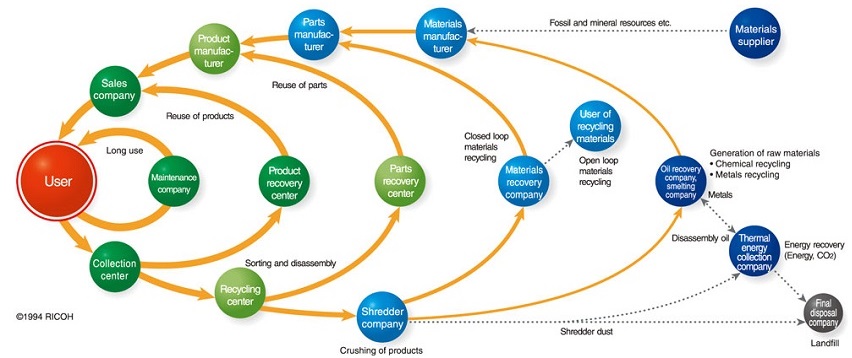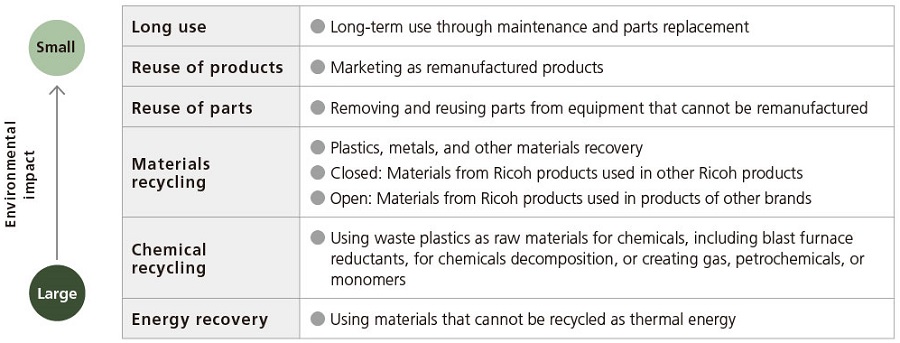Comet Circle
The Ricoh Group contributes to the development of a circular economy based on the Comet Circle concept.
Each sphere in the figure shows a partner to realize a sound circular economy. New resources that materials suppliers in the upper right of the chart harvest from nature traverse the right through left of the upper route to become products that reach customer users. In a linear economy with mass production and mass consumption, used products flow from left to right across the bottom route, reaching landfill after energy recovery.
Under our circular economy approach, collection and recycling centers process used products and return them to the upper route. Products not sorted as products and parts return to the upper route as materials. The orange arrows in the chart are product reuse, materials recycling, and other loops.

Four Action Guidelines Based on Comet Circle Concept
1. Identify and Reduce Environmental Impact from Lifecycle Perspectives
Efforts across the entire product lifecycles are pivotal to reducing environmental impacts. It is therefore necessary to understand not only our environmental impact, but also that of all business process participants. They include suppliers, customers, carriers, and recycling companies.
Therefore, we strive to reduce the total amount of environmental load by grasping the environmental impact of the entire life cycle, and promoting the development of environmental technology, 3Rs (Reduce, Reuse and Recycle) design of products, reduction of emissions in factories and offices, and procurement of PP & E* in consideration of resource recycling.
* PP & E: Plant, Property and Equipment
2. Deploy Reuse and Recycle Practices with Lower Environmental Impacts
The greatest economic value of a resource is ”The state in which the product is used by the customer.” Within the innermost Comet Circle loops, maintenance and other efforts at customer sites can preserve high value with minimal environmental impacts and costs.
When a product is no longer usable, it is important to restore high economic value with minimal environmental impact. We prioritize product and parts reuse loops to engineer as much reusage as we can. When usage becomes impossible, we recycle materials and then chemicals.

3. Establish a Circular Business Model
Resource recycling must be economically viable to progress. Instead of treating used products as waste, it is important to make them valuable again through innovation. Manufacturers must endeavor to provide recycled products and materials at minimal costs. Purchasers need to pay fair prices.
In keeping with Comet Circle loops, the Ricoh Group pursues and enhances 3Rs design from manufacturing stages to develop reusable products and parts, enabling long-term use. We have partnered with recycling companies to establish a financially sound business model with a low environmental impact across life cycles, improving recycled resources and minimizing energy and costs associated with reuse and recycling.
4. Partner with Stakeholders
Exchanging information and working closely with partners are vital to lowering environmental impact effectively. For example, by collaborating with material and parts manufacturers Ricoh can procure materials and parts whose CO2 emissions and new resources consumption are low, with minimal environmental hazards from the chemicals in them. It is important for shippers and carriers to jointly create eco-friendly and cost-efficient transportation modes.
Customers are our chief partners for product and services usage. Low environmental impact is a top priority for them. We therefore need to convey product information in an easy-to-understand manner and work with customers to assess and lower the environmental impact of our operations. We also need to collaborate with trade associations and other entities to formulate standards and create social frameworks with a view to reducing environmental impacts. Such stakeholder partnerships can shrink the eco footprints of offices, workplaces, and the economy.
Considering the intensification of climate change, resource depletion, population growth, and economic growth in developing countries, a mass-production and mass-consumption society is not sustainable. The Ricoh Group implements four action guidelines based on the Comet Circle, to expand the use of recycled resources, and curb virgin material usage.
Since the 1994 establishment of the Comet Circle, Ricoh has been striving to effectively utilize resources by building a mechanism to recycle products collected from the market and resupplying them to the market, based on the recognition that natural resources are irreplaceable. We will continue to maximize the value of resources through activities covering the entire life cycle.